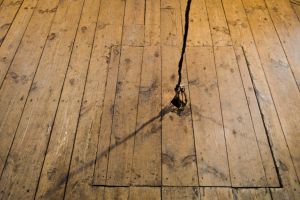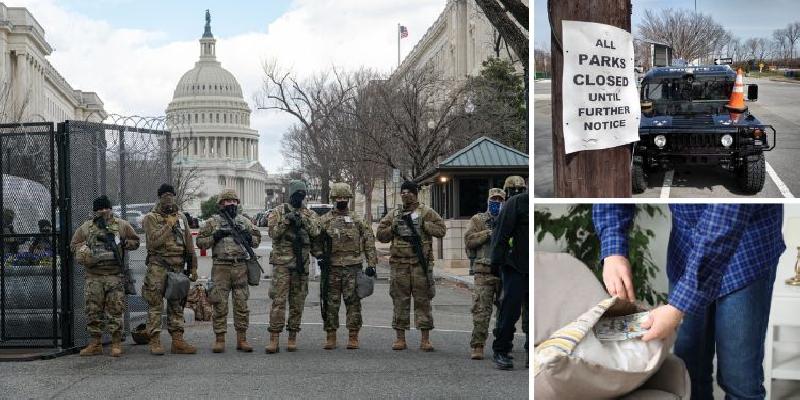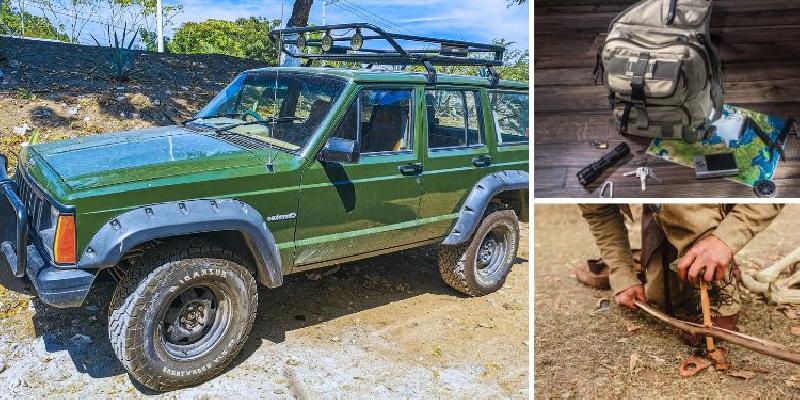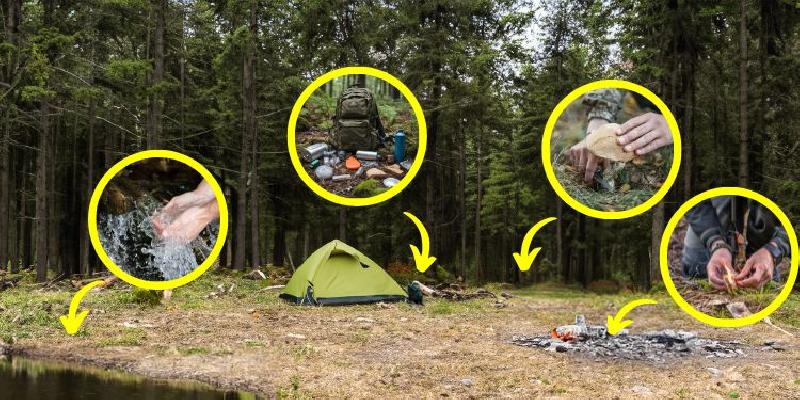Let’s say we’ve reached the moment everyone’s been afraid of. Disaster has struck so severely that the government declared martial law.
There might be chaos and pandemonium in the streets. Chances are people just aren’t as prepared as you are, and they might be willing to defy shelter-in-place orders to get what they need.
As much as this might seem like the time to load the shotgun and pull the curtains, there are always going to be crazies out there who think they can outgun Burt Gummer. Not to mention, the risk of someone breaking into your bug-out or bug-in location when you aren’t there!
If you’re worried about how to hide your supplies from would-be looters during martial law, or any other disasters, you might want to try some of the following.
Divide to Not Be Conquered
Regardless of the specific strategy you use to hide your supplies, the wise move is to split up your supplies into multiple batches. That way if a successful looter does get access to your wares, they might find some, but not all of them.
Ideally, you want your various stashes to have redundancy. Rather than putting all the toilet paper in one place, all the antibiotics in another, and the MREs all in one big box. Try putting a little of everything in each stash.
Unfortunately, having a stockpile of antibiotics, let alone two or more, is very hard. However, you can learn here how to stockpile antibiotics for a prescription before the next crisis hits.
Create a Sacrificial Stash
A good supply-hiding strategy also needs to deploy a little deceptive psychology. Let’s imagine a situation where Burt Gummer’s grandson is threatening to shoot his way in, or you’re simply away when would-be looters get at your shelter.
You can trust that they’ll keep searching until they find something. They’re not going to believe that you’ve been living on saltines and herbal tea.

So let’s say they find a 55-gallon barrel drum or a big tote with a modest handful of supplies. This small sacrificial stash makes it look like you’re already running desperately low. An inventory sheet with most everything checked off, and a bunch of empty cans and pouches in a nearby waste bin sells the perception that you’ve been foolishly overeating.
Don’t Hide Supplies in Light Items
Hiding supplies inside lightweight items, like a potted plant with a false bottom might sound brilliant on paper. In real life when someone is looking for anything of value they will quickly ransack, smash, and knock things over hoping to get lucky.
If they find one potted plant with a false bottom filled with MREs or a heavy flour canister loaded with 22 LR ammo, you can bet they’ll completely toss the place.
They might even start to get rough with your family members trying to get you to talk.
A Discrete Outdoor Storage Bunker
A storage supply bunker hidden outside away from the house or in an outbuilding gives you a great fallback stash. Even if your house does get ransacked and they find the supplies of value, you can still tape into the exterior stash to get you by.
Of course, anything stashed above ground outside has a real risk of spoiling or degrading. So, this is a strategy that’s better suited for things like fuel, and sealed MREs rather than canned goods or ammo.
The trick is to leave these supplies alone, and untouched until you absolutely have to access them. If you have a bunker hidden under the brush pile, or underneath some strawbales in the pole barn, you’ll leave a trail every time you affect the area.
Buried PVC Stashes

Imagine a scenario where looters get into your house, or they try to shoot their way in, and you have to evacuate.
Sealed PVC tubes buried in remote locations on your property give you fallback stashes you can use to either move on or take back your house when the time is right.
You can make all kinds of these loaded with non-perishable food and medical supplies. The ends of the PVC can be sealed watertight. If you bury it 2 feet deep in a shady spot, the tubes will be pretty much insulated from the effects of weather.
Inside an Exterior Liquid Propane Tank
If your rural property already has an outdoor propane tank, a second false tank can be a great exterior storage depot. It doesn’t have to be a massive tank that looks like it’s capable of heating the whole house.
You can usually find disused 100 or 200-gallon options by searching online for “Salvage Propane Tanks.” You could even go with an exterior fuel oil tank.
Attach some simple plumbing that runs a pipe into the ground, and you can position it just about anywhere near the house. Use a cutting torch to open a seam and turn it into a concealed door. A fresh coat of paint, and perhaps some repurposed gas service stickers hide everything in plain sight!
A False Rain Barrel
Assuming you’ve got a rain barrel system set up on your home, garage, or outbuildings, it’s easy to add another one or two. Instead of plumbing them into the system, you use them to store supplies.
Some dummy plumbing fixtures and hardware will make it look convincing enough to a looter. However, the inside of a rain barrel is going to get very hot on a warm summer day. So, it’s not the place to store anything remotely perishable or heat sensitive.
Secret Under-the-Floor Storage

Under-floor storage compartments are a great way to stash a fair amount of supplies out of sight. Especially if you don’t have a formal basement or a basement crawlspace.
After accessing the subfloor stringers, you can easily install a series of milk cartons using heavy-duty fasteners.
Then conceal the underside of the milk cartons in the basement or crawlspace.
Flooring and location are also important factors. Ideally, you want it to be a closet or a lesser-used part of your home. The area will sound different when anyone, like a looter, walks over it.
A closet floor makes it easy to plausibly hide the door seam under old shoes and lightboxes. Under the bed in the guest bedroom is also a good option.
When it comes to flooring type, a hardwood floor can be troublesome as it leaves a noticeable seam where the boards meet unevenly. A tile floor is easier. Especially if you have dark grout lines. With a carpeted floor, try to hide the door seam at the natural edges of the carpet.
Inside Heavy Furniture
The underside of a big couch, or a hide-a-bed that isn’t truly a hide-a-bed is another easy place to hide supplies in plain sight. This is a much better alternative to things like a fake potted plant.
Would-be looters might toss sofa cushions, zip or even cut into them. They might pick a couch to look under it. However, inspecting the frame where you can conceal shallow totes behind a thin sheet of furniture-grade particle board made from cheap lumber won’t look suspicious.
Stairwell Drawers

Stairs are always creaky and a looter likely wouldn’t even notice that they sound slightly off when stepped on.
They’re also an area of inefficiently used space in most homes. So, why not kill two birds with one stone and turn your stairwell into a hidden storage space for prepping supplies?
The riser should lift up using a hidden recessed hinge. A firm latch will also keep each riser locked in place. You’ll also want to seal it in with plywood or drywall that’s painted to match.
Taped Inside Old Speakers
Old speakers are just big boxes that can be repurposed to store prepping supplies. You just take a cone out with simple tools, to secure supplies inside.
The trick here is to tape down those supplies or somehow secure them so they don’t rattle or clunk when the speaker gets shaken. A looter might pick it up and give it a toss, but likely won’t put in the effort to tear it open.
You could secure pouches of MREs or boxes of lightweight bandages. Canned vegetables or pills probably aren’t ideal for secret speaker storage.
A False Wall in a Pantry, Cupboard, or Closet

If your home is blessed with a deep built-in pantry, reach-in cupboards, or closets with a lot of depth, a false back wall can make an excellent place to hide supplies. However, there are a few tricks to making this work properly.
The false wall needs to go from corner to corner to hide the seam. You also don’t want to go too big, as would-be looters might notice the difference in thickness if it’s more than say 10 to 12 inches deep.
Inside Spray Foam Attic Insulation
While most attics offer a lot of disused space, they also tend to get very hot and humid, which can degrade long-term stored supplies. One possible way around this, to make use of the space is to seal supplies inside spray foam insulation.
The closed cells will greatly reduce thermal transfer to keep the supplies at a reasonable temperature. It also hides them until you need them. Just be sure to put the supplies into sealable plastic bags before applying the spray foam.
When you need them later, a box cutter can carve the bag out of the foam in less than a minute.
Inside an Old Spare Tire
A spare tire is a wonderful place to hide your supplies in plain sight. It also lets you make use of the available space in the garage. This is a strategy that’s been used by drug smugglers for years.
It takes a lot of work for a would-be looter to get at your stashed items. Even if they get wise to the strategy. It makes it hard for them to raid your stash on foot, as they can’t easily grab the supplies and go.
A loaded tire will also be poorly balanced, causing it to roll poorly, wobble and fall over. Any would-be looter will constantly have to manage the tire while trying to make their slow retreat.
Of course, once the tire is fully inflated and stashed with supplies, it will also be hard for you to get at the contents. So, it’s better for storing next month’s MREs, rather than the ammo or medical supplies you might need at a moment’s notice.
During a time of martial law, you need to take a multi-pronged approach to hiding your supplies. This starts with dividing up your supplies so that if any one stash is found by would-be looters, you don’t lose everything.
Creating a sacrificial stash that’s easy to find, and making it look like you’ve already been tapping into it foolishly, might be enough to get them to move on. Empty MRE pouches and cans along with a checked-off inventory list might be enough to convince them you don’t have anything else worth scrounging around for.
Interior hidden storage bays under a closet floor or inside the frame of heavy furniture give you a good place to stash supplies that you want close at hand. Exterior storage areas like dummy tanks, and rain barrels are also handy bulk storage options.
Burying some sealed PVC tubes at the fringe of your property gives you a backup stash. This might come in handy if looters overwhelm your home and you’re forced to flee leaving your interior supplies behind.
In such a scenario, knowing how to survive in the wilderness becomes crucial. If urban areas become too dangerous, seeking refuge in more remote locations might be your best option. Surviving in the wild isn’t just about basic skills—it’s about knowing how to live off the land long-term.
That’s why I rely on the Long-Term Wilderness Survival Guide. This isn’t your typical survival manual; it’s a practical tool that teaches you the forgotten wisdom of our ancestors who didn’t just survive in the wild – they thrived there. So, when you need to head for the hills, make sure this handbook is in your backpack; it could be your lifeline in uncertain times.
By combining these strategic hiding spots with the knowledge of wilderness survival, you’ll be better prepared to face the challenges that come with martial law and protect your essential supplies from those who might try to take them.
via askaprepper




